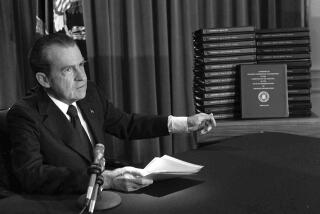‘Reinvented Government’ Savings: More Like a Whimper Than a Bang
The federal government has run a budget deficit for 23 straight years. The odds of this streak ending anytime soon are about the same as Americans dominating the luge competition in next year’s Winter Olympics.
With public frustration over government mounting, the party traditionally associated with big government--with more spending, higher taxes, more regulation, new mandates on business--refreshingly ran in the 1992 presidential election on the theme of reinventing government. The official report of the National Performance Review--Vice President Al Gore’s allegedly exhaustive review and evaluation of the federal government--is marketed as a way to create a government that works better and costs less.
It contains some good ideas--many proposed previously by Republican Presidents, only to be blocked by Congress--but it turns out to be much more a whimper than a bang.
The Administration claims the first set of legislative proposals would save $6 billion through 1998, with several rounds of additional proposals yet to come. But the Congressional Budget Office, after careful review, concludes that the savings would be about $300 million, or only 5% of the Clinton claim.
(The extravagant claims for White House budget proposals have had Administration officials backpedaling from the budget to the health care reform proposals--which are underfinanced by $100 billion a year, despite the President’s claim they will reduce the deficit. But that’s a story for another time.)
To place this in perspective, the CBO projects that the federal government will spend $9.5 trillion dollars through 1998. That is $9,500 billion dollars. The $300 million dollars is the equivalent of 30 out of every $10,000 projected to be spent by the federal government.
Do you think you could manage to save 30 the next time you spend $10,000? Compare the federal government’s voracious appetite for spending (let alone the huge additional costs imposed on the private sector through unnecessary regulation and mandates) to gorging on three Big Macs, two large fries and a jumbo Coke, and the first set of proposals adds up to skipping the pickle on one of the burgers.
That’s not much of a diet, and it offers little prospect of reducing the “waste line” over the long run.
*
Don’t get me wrong. I support many of the proposals in the National Performance Review. But they will not make the vast majority of government programs more efficient or less costly. One proposal is to get us tax refunds slightly faster. But this is the same Administration that passed the largest tax increase in the nation’s history. Another proposal is to reduce the number of federal employees (by attrition). But the Administration at the same time proposes the most expensive and blatantly bureaucratic new program in half a century: its unworkable, unhealthy and economically dangerous health care reform proposals.
And the President (after promising another round of spending cuts to pass his anti-growth budget this summer), along with the House leadership, just scuttled the only serious program to start to control spending: the proposal of rising GOP star John R. Kasich of Ohio and retiring moderate Democrat Timothy J. Penny of Minnesota.
Their plan would have reduced projected spending about 1% over five years (actual spending would still have risen substantially.) In its place, the House passed a small spending cut that is meaningless, since the funds saved can just be spent elsewhere. That won’t reduce the deficit.
The federal government spends, borrows and taxes too much. Its spending is too rarely cost-conscious or target-effective in the sense of landing most of the resources on the targeted population or problem.
In my view, far more radical surgery--more fundamental reform--is not only necessary but urgent. There is a sizable amount of spending that yields poor returns per taxpayer dollar that should be curtailed even if the government ran a surplus.
Sunsetting--that is, phasing out by a date--certain programs is desirable, as is zero-based budgeting--reviewing the entire program and budget, not just the increase for next year.
The President has too little leverage to control Congress’ appetite for spending; a line-item veto is long overdue (although in this year’s budget, Congress was less interested in new spending than the President was).
*
Far greater use should also be made of private-sector business methods, from outsourcing (when it is less expensive) to outright privatization.
And many government programs should be amalgamated or better integrated so the users can take advantage of “one-stop shopping.”
Others should be scrapped in favor of vouchers, which could be used to purchase the services from the private sector.
Job training is a good example. Do you think workers in need of retraining will get skills better suited to permanent, private-sector employment from a government program designed by Labor Department bureaucrats or from private firms that must demonstrate they can teach skills in demand in the commercial market in order to attract trainees and their vouchers?
Let’s all get behind the idea of creating a government that works better and costs less. But we’ll have to do a lot more than just skip an occasional pickle on a Big Mac. The Penny-Kasich proposal was at least a first serious step in the right direction. It should be revived early next year, along with an expected companion proposal in the Senate by Bob Kerrey (D-Neb.) and John Danforth (R-Mo.).
More to Read
Get the L.A. Times Politics newsletter
Deeply reported insights into legislation, politics and policy from Sacramento, Washington and beyond. In your inbox three times per week.
You may occasionally receive promotional content from the Los Angeles Times.










